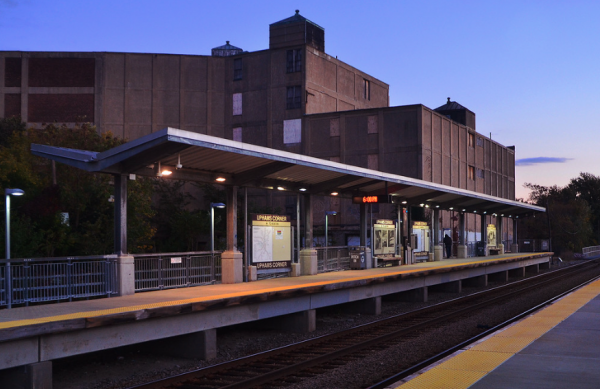January 19, 2017
 Uphams Corner: The Fairmount Line has spurred some new development along its route. The Leon Electric building, which hulks over the Uphams Corner station platform, has not yet been unlocked for redevelopment, however. Photo by Chris Lovett
Uphams Corner: The Fairmount Line has spurred some new development along its route. The Leon Electric building, which hulks over the Uphams Corner station platform, has not yet been unlocked for redevelopment, however. Photo by Chris Lovett
Mayor Walsh’s third State of the City (SOTC) address gave a general boost to the Fairmount Line as a potential jobs and transit engine. The mayor mentioned the line on two occasions in his half-hour-long speech, but as often is the case in the annual SOTC, there was no time to elaborate on what the mayor means in detail when he pledged that “We’re going to make the Fairmount Line a jobs corridor…”
One can surmise that the mayor and his team envision the Fairmount as a catalyst for elusive manufacturing sector jobs. The mayor did not mention, perhaps due to time constraints, that heavy state investment along the Fairmount Line has already triggered economic growth in Uphams Corner and Mattapan— with the help of city leadership. The city’s Department of Neighborhood Development has already successfully sought out and awarded development contracts for two key city-controlled parcels in both neighborhoods: Cote Village in Mattapan and the Indigo Block in Uphams Corner.
In both instances, these mixed-use redevelopments will result in new housing on what have been discarded and forlorn parcels near the railway. In the case of Uphams Corner’s Indigo Block, the innovative plan will include business manufacturing space.
But how will the city make good on Walsh’s pledge to make this a bona-fide jobs corridor? It’s an open question. The city had seized those two parcels— the old Cote Ford on Cummins Highway and the former Maxwell Box Company on West Cottage Street— and could thus control their redevelopment. The Walsh team— and its partners in state government— will have a tougher nut to crack when it comes to privately held land along the Fairmount right-of-way.
Case in point: the Leon Electric Building, the hulking warehouse building that sits cheek-to-jowl with the Uphams Corner station on Dudley Street. It is the number one target for transit-oriented redevelopment along the Fairmount spur— and its ownership has been notoriously unmoved by repeated entreaties to improve or redevelop the structure over the last two decades.
So pressing is the need for a solution at the Leon Electric site that the Reporter singled out the site as a case study in the newspaper’s 2013 questionnaire that was presented to the full field of mayoral candidates. We asked the candidates to tell us how they would tackle the redevelopment of this specific site— and how that would inform how they approach other thorny re-development issues citywide.
We received some thoughtful responses. Mike Ross, one of Walsh’s rivals for mayor, held a press event outside the Leon building to highlight his approach and to pitch his plan to build 10,000 units of housing just along the Fairmount corridor.
It’s worth recalling elements of Walsh’s response in the context of his SOTC speech. The then-state rep called for a “multi-pronged approach,” that included making it clear that “if the owner is not already willing to sell… the city is interested in brokering the sale of the property to a new owner.” Ultimately, he saw the Leon building as a prime site for mixed incomes/mixed use redevelopment, with an “adjacent outdoor space that could be a neighborhood plaza for events, farmers markets, and art markets.”
Three years into his administration, the Leon building remains a huge missing link in the Uphams Corner and Fairmount puzzle. That’s not a slight on the mayor. But since Walsh made the Fairmount one of the centerpieces of his SOTC address, it’s worth asking again: How exactly will the city administration approach key parcels like Leon that could help unlock the Fairmount’s full potential? We hope to see and hear more specific plans in the weeks to come.
Lastly, there’s one thing we can embrace wholeheartedly: The mayor is spot-on when he looks at the Fairmount line and sees potential for growth. It’s time to redouble our collective efforts to make sure that the momentum continues.
Topics:


